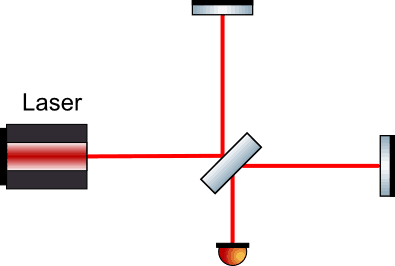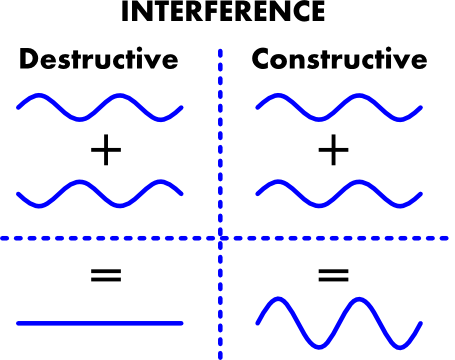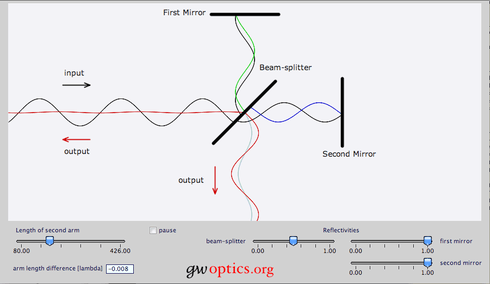Interferometery
To detect gravitational waves we need extremely precise instruments to measure distances on incredibly small scales. A gravitational wave affects lengths on scales around a billionth of a billionth of a metre, so we need an instrument sensitive enough to "see" on these scales!

A Michelson interferometer should be a very simple piece of kit; it consists of just three mirrors, a detector and a light source! The mirrors reflect the light source and the detector observes the light once it's been reflected. Of course in the hands of scientists even something simple can become very complex, but we can still try to understand the basic way in which it works.
Light from the source hits the first mirror at an angle. Since this mirror is half transparent, half of the light is reflected from the mirror and goes in one direction, while the other half of the light goes straight through. This first mirror is normally called the 'beam-splitter', because that's exactly what it does; it splits the light beam in two.
So now we have two identical beams travelling in different directions away from the beam-splitter. The different paths of these two beams are usually called the two 'arms' of the interferometer. At the end of each arm is another mirror. These 'end mirrors' are totally reflective, so all the light that hits them is reflected back towards the beam-splitter.
Now we get to the really interesting bit! When the beams get back to the beam-splitter, half of each is reflected, and the other half of each goes straight through, as before. The crucial bit now though is that the beams from the two arms INTERFERE....and that is why we call it an INTERFERometer.
Interference happens whenever you add one wave on top of another. If the two waves being added have their crests at the same point and their troughs (the low bits) at the same point, they add up to make an even bigger wave. This is called constructive interference, because it 'constructs' a bigger wave. But, if the crest of one wave is at the same point as the trough of the other wave, and vice versa, they cancel out and the waves disappear. This is called 'destructive interference' because the two waves apppear to have been destroyed. When you add two waves together, the size of the resulting wave depends on the difference in positions of the crests and troughs of the two original waves.

We can often describe light as being made up of waves, so if you add two light beams together you expect to see interference just like with any other waves. This is what happens when the two light beams come back to the beam-splitter and recombine; we get a light beam coming out from the interferometer with a brightness that depends on the the difference in positions of the crests and troughs of the beam waves from the two arms. The crest and trough positions from each arm depends on the exact length of that arm. So by measuring the power of the light beam coming out of the interfereometer we can see how well matched the crests and troughs in both arms are, and hence we can tell if there's any difference in the length of the arms! Since the length of the waves that make up light beams is very small (about a thousandth of a millimetre!) we can measure the difference in length of the two arms very, very accurately!
The light power in the output of a Michelson interferometer depends on the difference in length between its two arms. Have a look at our Processing sketch Michelson Interferometer to see how that works and how the interference effect can cancel or increase the light waves:


